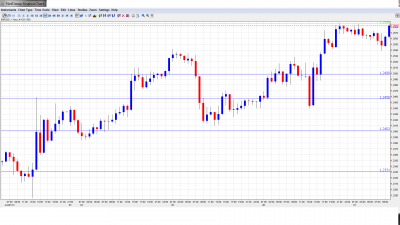EUR/USD is trading higher, in anticipation on some solution for Spain and hopes for hints about more QE in the US. As widely expected, the ECB did not lower interest rates on Wednesday. The markets were hoping for a reduction of 0.25%, although few were surprised that rates stayed put. After the interest rate decision, ECB head Draghi again called upon the EZ governments to take action to stabilize the EZ and the euro. Today’s Spanish government debt auction went well, raising slightly more funds than expected. Other key releases today include US Unemployment Claims and Fed Chairman Beranke’s testimony before the Joint Economic Committee in Washington.
Here’s an update on technicals, fundamentals and what’s going on in the markets.
EUR/USD Technicals
- Asian session: The pair climbed to 1.2583, and consolidated at 1.2567. The euro has edged upwards in the European session, trading at 1.2586.
- Current range: 1.25 to 1.2587.
- Further levels in both directions: Below: 1.25, 1.2460, 1.24, 1.2330, 1.22, 1.2144, 1.20, 1.1876 and 1.17.
- Above: 1.2587, 1.2623, 1.2660, 1.2760 and 1.2814.
- 1.25 has strengthened slightly in a support role.
- 1.2587 is a strong resistance line.
Euro/Dollar moves upwards after ECB maintains interest rates – click on the graph to enlarge.
EUR/USD Fundamentals
- Tentative: Spanish 10-y Bond Auction.
- Tentative: French 10-y Bond Auction.
- 12:30 US Unemployment Claims. Exp. +381K.
- 14:00 Fed Chairman Bernanke Testifies.
- 14:30 US Natural Gas Storage. Exp. +57B.
- 16:10 FOMC Member Lockhart Speaks.
- 19:00 US Consumer Credit. Exp. +10.8B.
For more events and lines, see the Euro to dollar forecast
EUR/USD Sentiment
- Markets disappointed by ECB: The markets were hopeful that the ECB would show some leadership in a crisis situation, and perhaps lower interest rates by 0.25%. The central bank chose not to make a move, and maintained rates at 1.0%. ECB head Draghi stated yet again that it was up to the EZ leaders to take the tough decisions needed to stabilize the zone and the euro. Draghi had little to offer in way of support, and made no mention of any new easing measures to help the markets.
- Hopes for QE3: After the terrible jobs report, Bernanke’s testimony is closely watched. Will he hint for more monetary stimulus on the June 20th meeting? QE3 doesn’t seem effective at this point. Nevertheless, the Fed is expected to “do something”. More dollar printing weakens the dollar and pushes other assets higher.
- Weak German data: As if the EZ doesn’t have enough on its plate, Germany, the reliable locomotive of the EZ, is showing signs of weakness. German Factory Orders was the latest bad news, declining -1.9%. Germans appear to be fed up with the situation in Greece – a poll found that half of all Germans would like to see Greece leave the Euro-zone. It’s a stretch to point a finger at Greece for weak German factory orders, but it seems clear that Germany is tired of supporting the weaker EZ members.
- Bailout for Spain?: Reports have surfaced suggesting that a bailout plan for Spain, the euro area’s fourth largest economy, is in the works and that Germany is pressuring Spain to accept such a program. The report suggests a minimal package of 50 to 80 billion euros to shore up the ailing banking sector. Spanish 10 year bond yields remain extremely high, at around 6.50%. Spain’s Treasury Minister Cristobal Montoro has declared that financial markets are effectively closed to Spain because of the current high level of the country’s borrowing costs. There is no longer any doubt that Spain needs European assistance to recapitalise their broken banks. Exactly how to go about this promises to be a sticky problem. At today’s 10 year Spanish government debt auction, Spain raised over EUR 2 billion, but the yield was very high, above 6%. A bailout for troubled Spain may not be far away.
- US recovery in trouble?: Recent US employment data was very weak, and other economic releases have not been impressive. This casts yet another shadow on global growth. There is not much likelihood of action by the Fed, since inflation isn’t low enough and the effect of bond buying with historically low US yields is meaningless. The Fed may have exhausted its options, although things could change in a hurry if the US economic recovery sputters.
- Uncertainty over Greek elections: The last polls for the Greek elections were mixed: some show a tie between leading pro-bailout New Democracy and anti-bailout SYRIZA. Others show one of the parties leading. Election polls are now officially banned, so at least we won’t see the euro bouncing up or down based on the latest Greek election poll. The election of the anti-bailout SYRIZA party will certainly accelerate a Greek exit from the EZ, but the election is too close to call and will likely remain so right down to the wire. See how to trade the Grexit with EUR/USD.
- Money leaving Greece: With all the political and fiscal uncertainty plaguing Greece, it’s no exaggeration to see the country is a mess. Greek banks received 18 billion euros in recapitalization money but this seems like a temporary relief. Companies are moving money out of the country, and the bigger problem is with tax payments: many Greeks are deferring tax payments and this weighs heavily on the state coffers, which are running dry. Winning the Greek election may be the easy part – the new government will have to contend with crippling economic problems.

